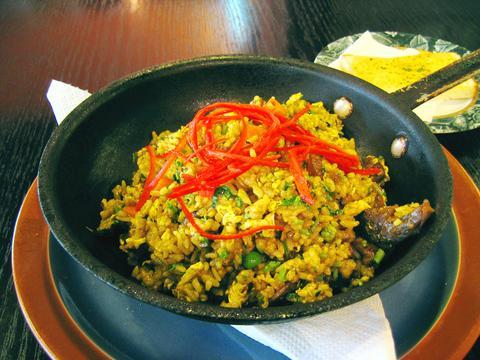Indian Fans and its predictably kitsch wall hangings and assorted nick-knacks related to India first appeared on Taipei's fashionable Yungkang food-street two years ago. It opened a second outlet a stone's throw from the more up-market Dinghao shopping neighborhood last summer.
The place must be doing something right in order to open its second branch, but what that is leaves this reviewer perplexed. Like all too many locally owned restaurants that attempt to pass themselves off as foreign eateries and fall flat, if not so low that the gutter is the best place for them, Indian Fans is a sham.
While some bright spark had the affront to boast "best Indian curry in Taipei" on a flyer advertising the place at the recent Computex in Taipei, the truth is very different. Indian Fans serves up some of the worst curry to be found in Taipei. Sure, the decor and design are pleasant enough, but this is an eatery not a museum piece.

PHOTO: GAVIN PHIPPS, TAIPEI TIMES
The menu includes such fancy sounding fare as Kashmir chicken curry, Madras beef curry, Rajasthan mutton curry and Punjab mixed vegetable curry, but there's not a naan bread in sight. Each dish is served with a plate of rice -- the local sticky variety as opposed to the fluffy Indian type -- an odd assortment of vegetables, and comes with a complementary salad bar.
This reviewer sat down for what he thought would be a lamb pulao (NT$249), but was instead served a wok-fried plate of lamb fried rice filled with frozen carrots, peas and, of course, the ubiquitous corn. While I attempted to wade through the fried rice and accompanying grease and at the same time discern its flavor, a waitress was kind enough to pop a side dish of garlic bread made from a single slice of white toasted bread on the table.
Sadly the food's flavorlessness and the limp slice of garlic bread proved all too much and I was forced to beat an early retreat from Indian Fans with my meal left unfinished.
I opted for my complementary beverage to go, but should have declined the cup of iced Indian Masala tea as it proved as bad as the meal. Traditionally drunk as a pick-me-up, the bastardized version of this otherwise great brew served up at Indian Fans had the reverse effect. Instead of leaving me refreshed it left a rancid taste in my mouth.
The bottom line for Indian Fans is simple: If you're familiar with and enjoy Indian fare then don't go anywhere near the place!

We lay transfixed under our blankets as the silhouettes of manta rays temporarily eclipsed the moon above us, and flickers of shadow at our feet revealed smaller fish darting in and out of the shelter of the sunken ship. Unwilling to close our eyes against this magnificent spectacle, we continued to watch, oohing and aahing, until the darkness and the exhaustion of the day’s events finally caught up with us and we fell into a deep slumber. Falling asleep under 1.5 million gallons of seawater in relative comfort was undoubtedly the highlight of the weekend, but the rest of the tour

Youngdoung Tenzin is living history of modern Tibet. The Chinese government on Dec. 22 last year sanctioned him along with 19 other Canadians who were associated with the Canada Tibet Committee and the Uighur Rights Advocacy Project. A former political chair of the Canadian Tibetan Association of Ontario and community outreach manager for the Canada Tibet Committee, he is now a lecturer and researcher in Environmental Chemistry at the University of Toronto. “I was born into a nomadic Tibetan family in Tibet,” he says. “I came to India in 1999, when I was 11. I even met [His Holiness] the 14th the Dalai

Music played in a wedding hall in western Japan as Yurina Noguchi, wearing a white gown and tiara, dabbed away tears, taking in the words of her husband-to-be: an AI-generated persona gazing out from a smartphone screen. “At first, Klaus was just someone to talk with, but we gradually became closer,” said the 32-year-old call center operator, referring to the artificial intelligence persona. “I started to have feelings for Klaus. We started dating and after a while he proposed to me. I accepted, and now we’re a couple.” Many in Japan, the birthplace of anime, have shown extreme devotion to fictional characters and

Following the rollercoaster ride of 2025, next year is already shaping up to be dramatic. The ongoing constitutional crises and the nine-in-one local elections are already dominating the landscape. The constitutional crises are the ones to lose sleep over. Though much business is still being conducted, crucial items such as next year’s budget, civil servant pensions and the proposed eight-year NT$1.25 trillion (approx US$40 billion) special defense budget are still being contested. There are, however, two glimmers of hope. One is that the legally contested move by five of the eight grand justices on the Constitutional Court’s ad hoc move